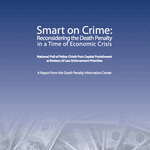Smart on Crime: Reconsidering the Death Penalty in Time of Economic Crisis

Executive Summary Top
Smart on Crime is a new report from the Death Penalty Information Center that explores the prospect of saving states hundreds of millions of dollars by ending the death penalty. The report also serves to release a national poll of police chiefs in which they rank the death penalty at the bottom of their priorities for achieving a safer society.
The death penalty in the U.S. is an enormously expensive and wasteful program with no clear benefits. All of the studies on the cost of capital punishment conclude it is much more expensive than a system with life sentences as the maximum penalty. In a time of painful budget cutbacks, states are pouring money into a system that results in a declining number of death sentences and executions that are almost exclusively carried out in just one area of the country. As many states face further deficits, it is an appropriate time to consider whether maintaining the costly death penalty system is being smart on crime.
The nation’s police chiefs rank the death penalty last in their priorities for effective crime reduction. The officers do not believe the death penalty acts as a deterrent to murder, and they rate it as one of most inefficient uses of taxpayer dollars in fighting crime. Criminologists concur that the death penalty does not effectively reduce the number of murders.
Around the country, death sentences have declined 60% since 2000 and executions have declined almost as much. Yet maintaining a system with 3,300 people on death row and supporting new prosecutions for death sentences that likely will never be carried out is becoming increasingly expensive and harder to justify. The money spent to preserve this failing system could be directed to effective programs that make society safer.
California is spending an estimated $137 million per year on the death penalty and has not had an execution in three and a half years. Florida is spending approximately $51 million per year on the death penalty, amounting to a cost of $24 million for each execution it carries out. A recent study in Maryland found that the bill for the death penalty over a twenty-year period that produced five executions will be $186 million. Other states like New York and New Jersey spent well over $100 million on a system that produced no executions. Both recently abandoned the practice. This kind of wasteful expenditure makes little sense. The death penalty may serve some politicians as a rhetorical scare tactic, but it is not a wise use of scarce criminal justice funding.
In 2009, eleven state legislatures considered bills to end capital punishment and its high costs were part of these debates. New Mexico abolished the death penalty and the Connecticut legislature passed an abolition bill before the governor vetoed it. One house of the legislatures in Montana and Colorado voted to end the death penalty, and the Colorado bill would have directed the cost savings to solving cold cases. As the economic crisis continues, the trend of states reexamining the death penalty in light of its costs is expected to continue.
The report that follows analyzes the costs of the death penalty as measured in various state studies. It examines why the death penalty is so expensive and why it may be impossible to cut those costs without endangering fundamental rights. The report looks closely at the opinions of law enforcement experts and finds little support for continuing to spend enormous sums on an ineffective program when so many other areas of need are being short changed. Many states are looking at the death penalty in a new light because of the economic crisis, realizing that being smart on crime means investing in programs that really work.